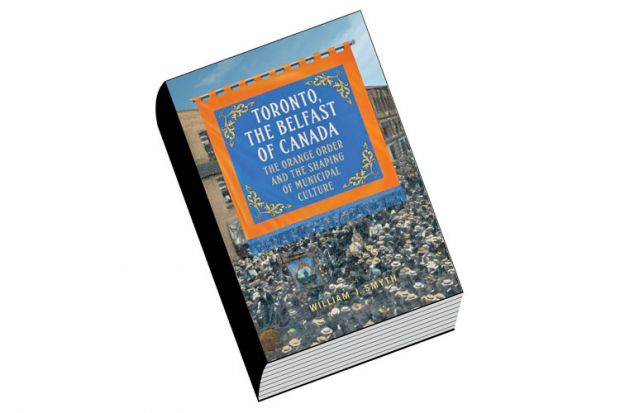Of all the descriptions readers might expect to have applied to Toronto, Canada’s version of Belfast is probably one of the more unexpected. Peter Ustinov’s quip that it is “New York run by the Swiss” seems a far more plausible summation of a city seemingly without controversy or discord. Despite today being the country’s largest urban centre, and during the time this book surveys its second-largest, it simply is not a place we would expect to find bitter sectarian feuding and large-scale Orange-Green violence, Ulster style. But that is precisely what Toronto was like in the wake of the Irish famine of 1845 to 1852. As William Smyth’s book shows, between the middle of the 19th century and the onset of the Second World War, “the Belfast of Canada” was a very appropriate label indeed, reflecting a set of intense cultural exchanges that affected not just Toronto but Canada more generally, and reflective of a wider loyalist culture.
Contrasts with other cities nearby serve to sharpen our understanding of Toronto. The transplantation of Ulster’s sectarian culture to Canada helped to enforce differences from the US. Nearby Buffalo, New York, is a case in point. Here, the Irish population came almost entirely from the southern provinces of Ireland, and was almost exclusively Catholic. Just 100 miles to the north in Toronto, however, the Irish population was more than 50 per cent Protestant and hailed mostly from the northernmost province, Ulster.
Orangeism and Ulster were the crucial variables here. Ulster dominated Irish migrations to Canada, and Protestants dominated within that flow, leaving Irish Catholics as a pressurised minority. During the 19th century, one-third of all British and Irish Protestant immigrants to Canada would join the Orange Order, and the organisation became even larger than it was back in Ulster. Orangeism became a crucial feature of urban, political and cultural life in Toronto and other cities, and it found friendly foundations. It embossed an extant Tory loyalist culture that was first forged by the United Empire Loyalists who fled north from the American Revolution.
Many of the features of Orange-Green conflict that marked Ulster’s history since the 1798 Rising also were found in Canada. Soldiers founded the first Orange lodges in the early 1800s, but the culture soon became established among Irish Protestant civilian populations in the Maritimes, Newfoundland, Ontario and parts of Quebec. Orangemen helped to put down the French and British liberal rebellions of 1837-38. And on the very same day that Orangemen and Hibernians engaged in infamous pitched battles at Dolly’s Brae in County Down in 1849, a dozen were left dead by similar clashes in New Brunswick.
One of the leading scholars of Orangeism, Smyth is, with Cecil Houston, author of the classic 1980 study The Sash Canada Wore: A Historical Geography of the Orange Order in Canada. This new book employs many of the same skills of historical geography to reconstruct lodges, communities and the socio-economic profiles of the Order and its members. Toronto, the Belfast of Canada locates Orangeism in a wider imperial frame, and deftly handles the comparisons with other territories – not least Belfast, where Smyth’s cross-analysis is detailed. He correctly correlates Canadian Orangeism with the Order in Ulster. In both places, it furnished legislators and civic office holders; businessmen and community leaders were members. Its political influence was far greater than in northern England – more even than Liverpool, whose Orange Order was only half the size of Toronto’s. In the US, where growth in the Orange Order was spurred by Protestant Irish settlers and re-migrating Canadians, the Order was small, contained and largely subsumed within American nativist organisations. Certainly Smyth is able to show that, in a comparative emigrant context, Orangeism in Canada was unique, and at the heart of it was Toronto.
Donald M. MacRaild is professor of British and Irish history, Ulster University, and author of Faith, Fraternity and Fighting: The Orange Order and Irish Migrants in Northern England, c.1850-1920 (2005).
Toronto, the Belfast of Canada: The Orange Order and the Shaping of Municipal Culture
By William J. Smyth
University of Toronto Press, 328pp, £42.99
ISBN 9781442646872
Published 7 July 2015
Register to continue
Why register?
- Registration is free and only takes a moment
- Once registered, you can read 3 articles a month
- Sign up for our newsletter
Subscribe
Or subscribe for unlimited access to:
- Unlimited access to news, views, insights & reviews
- Digital editions
- Digital access to THE’s university and college rankings analysis
Already registered or a current subscriber?




